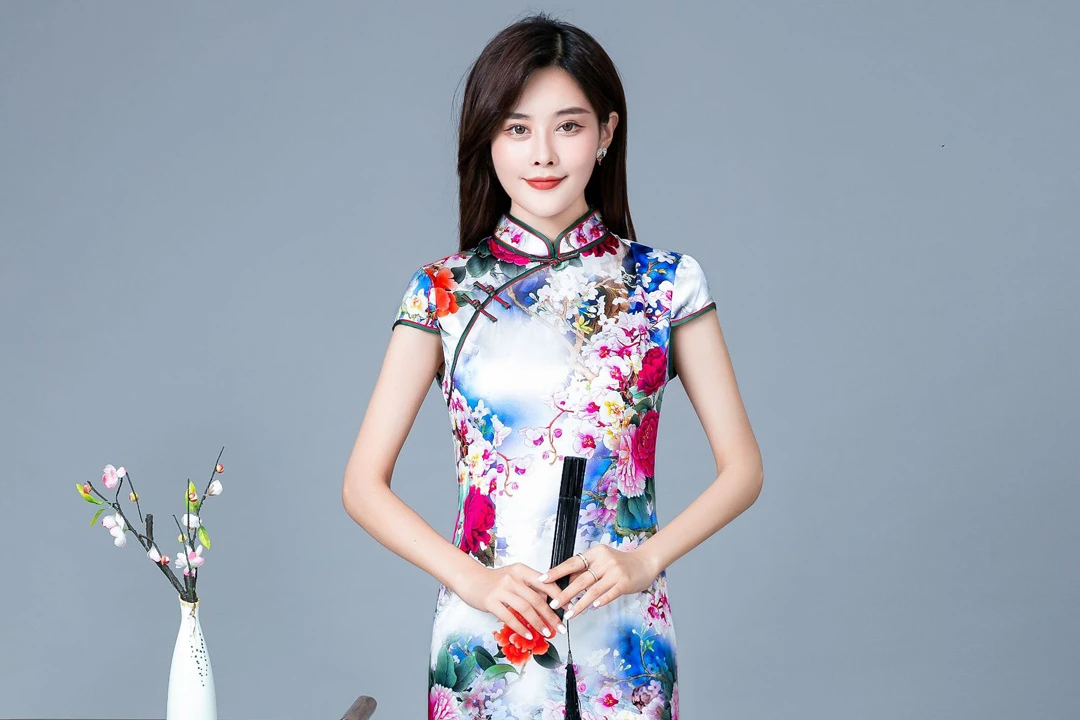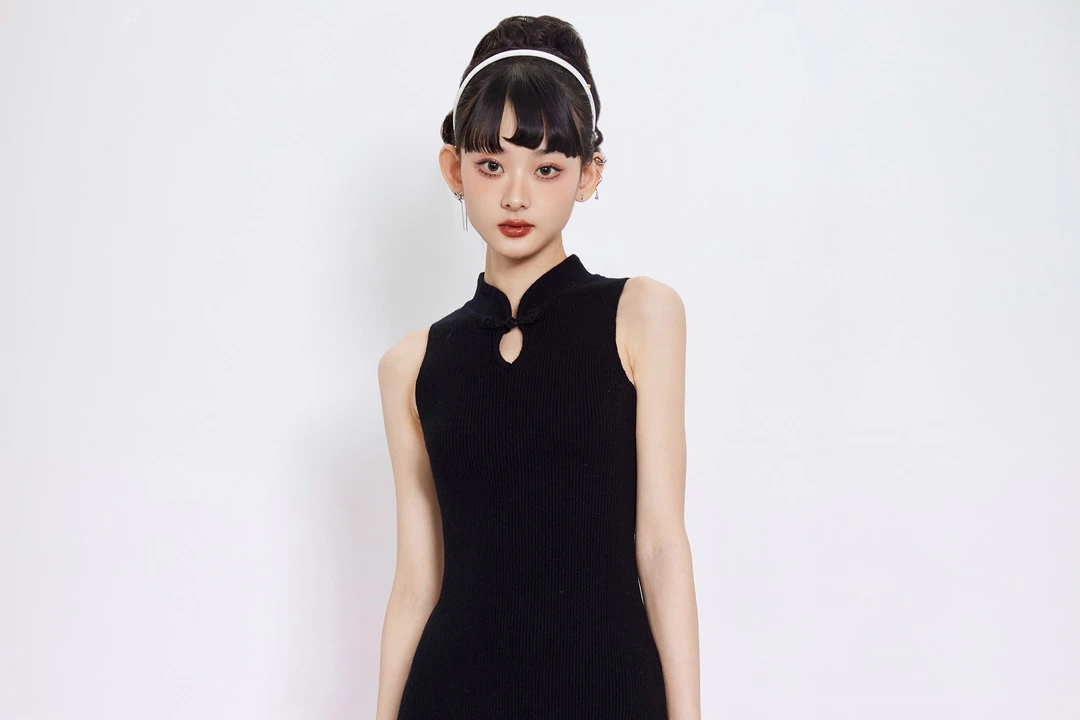The qipao, with its elegant silhouette and timeless allure, is a quintessential symbol of Chinese culture and fashion. Behind the beauty of this iconic garment lies a meticulous process of crafting, involving careful selection of materials, intricate tailoring techniques, and exquisite attention to detail. In this article, we explore the art of crafting qipao, focusing on the materials used, the techniques employed, and the importance of intricate details such as buttons and fastenings.
Crafting a qipao is a labor-intensive process that requires skill, precision, and attention to detail. The process typically begins with the selection of high-quality fabrics, followed by meticulous measurements and pattern-making. Skilled craftsmen then use traditional tailoring techniques such as hand-sewing and embroidery to construct the garment, ensuring a flawless fit and elegant drape. Finally, intricate details such as buttons, fastenings, and embellishments are added to enhance the qipao’s aesthetic appeal and cultural significance.
Choice of Materials
The choice of materials is crucial in crafting a qipao, as it determines the garment’s overall look, feel, and quality. Traditional qipao fabrics include silk, satin, and brocade, known for their luxurious texture and lustrous sheen. These fabrics are prized for their durability, breathability, and ability to drape gracefully over the body, creating a flattering silhouette. In recent years, designers have also experimented with modern fabrics such as lace, chiffon, and velvet, adding a contemporary twist to traditional qipao designs.
Silk is often considered the preferred fabric for crafting qipao, prized for its softness, smoothness, and natural sheen. Known as the “queen of fabrics,” silk drapes elegantly over the body, accentuating the curves and contours of the wearer. Silk qipao are highly sought after for their luxurious feel and timeless elegance, making them a popular choice for special occasions such as weddings, banquets, and formal events.
The art of crafting qipao involves a variety of intricate tailoring techniques, passed down through generations of skilled craftsmen. These techniques include hand-cutting, hand-sewing, and hand-finishing, each performed with precision and expertise. Seamstresses meticulously stitch together fabric panels, creating seamless lines and impeccable seams that enhance the qipao’s structure and fit. Embroidery, appliqué, and beading are also used to embellish the garment, adding intricate patterns and decorative motifs that showcase the artisan’s craftsmanship and attention to detail.
Importance of Qipao Buttons and Fastenings
Buttons and fastenings play a crucial role in qipao design, serving both functional and aesthetic purposes. Traditional qipao feature a row of handmade silk knots, known as “frogs,” which are used to fasten the garment at the front. These frogs are meticulously crafted using silk cord or thread, often embellished with intricate knots or decorative tassels. In addition to frogs, qipao may also feature ornate buttons, clasps, or closures made from materials such as jade, pearls, or precious metals, adding a touch of elegance and sophistication to the garment.
Buttons and fastenings hold symbolic significance in qipao design, reflecting cultural values, beliefs, and traditions. The number and placement of buttons may carry auspicious meanings, with odd numbers symbolizing good fortune and prosperity. Additionally, the materials used for buttons may hold symbolic significance, with jade representing longevity and wisdom, pearls symbolizing purity and elegance, and gold signifying wealth and prestige. By incorporating these symbolic elements into qipao design, craftsmen infuse the garment with deeper cultural meaning and significance, enriching its appeal and allure.
The art of crafting qipao is a testament to the rich heritage and craftsmanship of Chinese culture. From the careful selection of materials to the meticulous tailoring techniques and intricate details such as buttons and fastenings, each step in the crafting process reflects a tradition of excellence and artistry passed down through generations. As we continue to appreciate and celebrate the beauty of qipao, let us also recognize the skill and dedication of the craftsmen who bring this iconic garment to life, preserving its legacy for future generations to admire and cherish.
While traditional qipao designs adhere to classic principles and aesthetics, modern interpretations of the garment have evolved to reflect contemporary tastes and fashion trends. Designers experiment with innovative silhouettes, cuts, and embellishments, pushing the boundaries of qipao design while still honoring its cultural heritage. From sleek, minimalist styles to bold, avant-garde creations, modern qipao designs cater to a diverse range of preferences and occasions, ensuring the garment remains relevant and desirable in today’s fashion landscape.
Throughout history, qipao designs have been influenced by regional customs, cultural traditions, and stylistic preferences. Variations in fabric, color, embroidery, and silhouette distinguish qipao styles from different regions of China, each reflecting the unique cultural identity and heritage of its respective area. For example, qipao from Shanghai are known for their figure-hugging silhouettes and elaborate embroidery, while those from Guangdong feature lightweight fabrics and subtle embellishments. By celebrating these regional variations, qipao design embraces diversity and inclusivity, enriching its appeal and cultural significance.
In response to growing environmental concerns and sustainability initiatives, qipao craftsmen are adopting eco-friendly practices and materials in the crafting process. Sustainable fabrics such as organic silk, bamboo silk, and recycled fibers are increasingly being used in qipao production, reducing the garment’s environmental footprint and promoting ethical fashion practices. Additionally, traditional techniques such as hand-sewing and natural dyeing are being revived to minimize energy consumption and chemical pollution, preserving the artisanal heritage of qipao craftsmanship for future generations.
Global Influence and Adoption
Qipao’s timeless elegance and cultural allure have transcended geographical boundaries, gaining popularity and recognition on the global stage. From Hollywood red carpets to international fashion runways, qipao-inspired designs are embraced by celebrities, fashion influencers, and designers worldwide, showcasing China’s rich cultural heritage and artistic craftsmanship to a global audience. As a symbol of cross-cultural exchange and appreciation, qipao continues to inspire creativity, foster dialogue, and promote cultural understanding across continents and cultures.
Efforts to preserve and promote the art of qipao crafting are underway through various initiatives aimed at safeguarding traditional techniques and supporting artisans and craftsmen. Museums, cultural institutions, and educational organizations offer workshops, exhibitions, and training programs to educate the public about qipao’s cultural significance and craftsmanship. Additionally, government-sponsored initiatives and industry collaborations provide funding and resources to support qipao artisans, ensuring the continuity and vitality of this cherished cultural tradition.
The art of crafting qipao embodies a tradition of excellence, artistry, and cultural heritage that continues to inspire and captivate audiences worldwide. From the careful selection of materials to the intricate tailoring techniques and symbolic details such as buttons and fastenings, each aspect of qipao crafting reflects a legacy of craftsmanship and creativity passed down through generations. As we celebrate the beauty and cultural significance of qipao, let us also recognize the dedication and skill of the artisans who preserve and enrich this cherished tradition, ensuring its legacy for generations to come.
In contemporary fashion education, qipao crafting is increasingly recognized and integrated into curriculum and design programs. Fashion students have the opportunity to study qipao construction techniques, pattern-making, and design principles as part of their coursework. Through hands-on workshops, lectures, and internships with qipao artisans, students gain valuable insights into traditional craftsmanship and cultural heritage, fostering a deeper appreciation for qipao design and its significance in the global fashion industry.
Collaboration between qipao artisans and designers from diverse cultural backgrounds fosters cross-cultural exchange and creative innovation. By combining traditional qipao craftsmanship with contemporary design sensibilities, these collaborations produce unique and culturally resonant garments that bridge East and West, past and present. Through partnerships with international fashion brands, qipao artisans showcase their craftsmanship on a global stage, promoting cultural exchange and appreciation across borders.
Qipao in Specialized Fashion Markets
Qipao crafting has carved a niche in specialized fashion markets catering to niche clientele such as bridal wear, haute couture, and luxury fashion. High-end qipao boutiques offer bespoke services, allowing clients to customize every aspect of their garment, from fabric selection to design details. By catering to discerning clients who value craftsmanship, quality, and exclusivity, these specialized markets ensure the continued demand for handcrafted qipao garments and sustain the livelihoods of qipao artisans.
Qipao embodies China’s rich cultural heritage and serves as a symbol of national identity and pride. As a tangible expression of Chinese aesthetics and craftsmanship, qipao reflects the country’s millennia-old traditions, values, and artistic sensibilities. By preserving and promoting qipao crafting, China reaffirms its commitment to safeguarding cultural heritage and promoting cultural diplomacy, both domestically and internationally.
Qipao transcends mere garment-making; it represents a profound connection to China’s cultural heritage and artistic legacy. As artisans and designers continue to innovate and reinterpret traditional qipao designs, the garment evolves and adapts to contemporary fashion trends while retaining its timeless elegance and cultural significance. Through education, collaboration, and cultural exchange, qipao crafting thrives as a dynamic and vibrant expression of Chinese culture, enriching the global fashion landscape and inspiring future generations of designers and enthusiasts.


